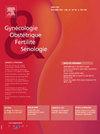[胎儿监护:目前的局限性和基于胎儿自主神经系统分析的新方法]。
IF 0.6
4区 医学
Q4 OBSTETRICS & GYNECOLOGY
引用次数: 0
摘要
目的:目前,分娩过程中的胎儿监护主要基于对胎儿心率(FHR)的视觉分析。这种检测方法并不完善,观察者内部和观察者之间的差异很大,对新生儿酸中毒或缺氧缺血性脑病发生的预测能力较差。在存在中度酸中毒风险的情况下,可以使用二线检测方法,如血头皮取样(测量 pH 值或乳酸)或胎儿心电图 ST 段分析。然而,这些侵入性检查有很多局限性,其地位也存在争议。一些学者建议采用更为生理学的方法来评估 FHR。维持胎儿平衡的主要角色是自律神经系统(ANS)。其活动可通过分析心率变异性(HRV)来评估。我们的目的是评估心率变异是否可用于识别有酸中毒风险的情况:我们的团队开发了一种测量心率变异的指数--胎儿压力指数。为了在酸中毒情况下进行测试,我们使用了怀孕母羊模型。我们还同时开发了一套人类胎儿心电图记录系统:结果:在我们的实验模型中,我们证明了该指数能反映副交感神经系统的变化,并与酸中毒的发生相关。由于在临床实践中使用该指标需要采集逐次搏动的 FHR 信号,我们还开发了一种腹部贴片,可对胎儿心电图进行高精度分析:因此,未来将利用我们的贴片获得的信号,在前瞻性队列中验证 FSI 作为酸中毒的标记。这将成为分娩过程中监测胎儿的新工具。本文章由计算机程序翻译,如有差异,请以英文原文为准。
Surveillance fœtale : limites actuelles et nouvelles pistes basées sur l’analyse du système nerveux autonome fœtal
Objective
Currently, fetal monitoring during labor is based on visual analysis of the fetal heart rate (FHR). This test is imperfect, with high intra- and inter-observer variability and a moderate to poor prediction of the occurrence of neonatal acidosis or anoxic-ischaemic encephalopathy. In situations where there is an intermediate risk of acidosis, it is possible to use second-line tests such as blood scalp sampling (with pH or lactate measurement) or ST segment analysis of the fetal ECG. However, these invasive tests have many limitations and their place is debated. Some authors suggest a more physiological approach to FHR assessment. The main actor in maintaining fetal homeostasis is the autonomic nervous system (ANS). Its activity can be assessed by analysing heart rate variability (HRV). The aim is to assess whether HRV can be used to identify situations at risk of acidosis.
Materials and methods
Our team has developed an index, the Fetal Stress Index, to measure HRV. To test it in a situation of acidosis, we used a pregnant ewe model. We also developed in parallel a human fetal ECG recording system.
Results
In our experimental model, we have shown that this index reflects variations in the parasympathetic system and correlates with the onset of acidosis. As its use in clinical practice requires the acquisition of a beat-to-beat FHR signal, we have also developed an abdominal patch that allows highly accurate analysis of the fetal ECG.
Conclusion
The future is therefore to validate the FSI as a marker of acidosis in a prospective cohort using the signal obtained from our patch. This could be a new tool for fetal monitoring during labor.
求助全文
通过发布文献求助,成功后即可免费获取论文全文。
去求助
来源期刊

Gynecologie Obstetrique Fertilite & Senologie
Medicine-Obstetrics and Gynecology
CiteScore
1.70
自引率
0.00%
发文量
170
期刊介绍:
Gynécologie Obstétrique Fertilité & Sénologie est un mensuel scientifique d''information et de formation destiné aux gynécologues, aux obstétriciens, aux sénologues et aux biologistes de la reproduction. La revue, dans ses éditoriaux, articles originaux, mises au point, lettres à la rédaction et autres rubriques, donne une information actualisée ayant trait à l''obstétrique et à la gynécologie et aux différentes spécialités développées à partir de ces deux pôles : médecine de la reproduction, médecine maternelle et fœtale, périnatalité, endocrinologie, chirurgie gynécologique, cancérologie pelvienne, sénologie, sexualité, psychosomatique…
 求助内容:
求助内容: 应助结果提醒方式:
应助结果提醒方式:


